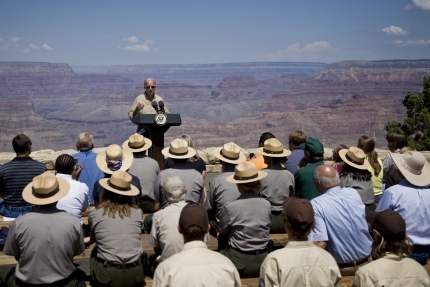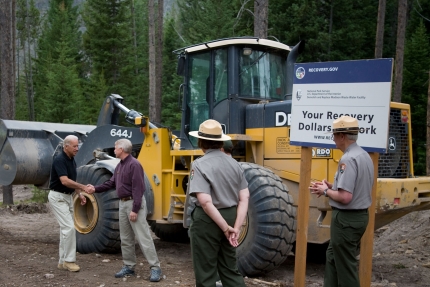The Recovery Act Blog
The Recovery Act: Laying the Foundation for America’s 21st Century Clean Energy Economy
Posted by on August 2, 2010 at 9:09 AM EDTLast week, I spoke at two events that helped underscore the extent to which President Obama’s Recovery Act is paving the way for a clean energy economy.
Before an audience of green affordable housing developers at the Communities of the Institute for Professional and Executive Development (IPED) annual conference, I highlighted four ways HUD is using the lessons of the Recovery Act to make this possible—first, by upgrading and retrofitting 230,000 units of HUD’s affordable housing stock to high green standards by the end of this summer; second, by providing new tools to property owners that demonstrate which green improvements they can make and the savings they can generate; third, by using the Federal Housing Administration (FHA) to catalyze new forms of green retrofit financing for single- and multi-family housing; and fourth, by forging interagency partnerships across government to weatherize homes and help clusters of communities work together to reduce the combined cost of housing and transportation.
Learn more about Energy and EnvironmentThe Vice President and the Recovery Act on the South Rim of the Grand Canyon
Posted by on July 30, 2010 at 2:30 PM EDTOn Tuesday, Vice President Biden continued his Recovery Summer tour at Grand Canyon National Park. Standing in front of the beautiful overlook at Hopi Point on the south rim of the canyon, we spoke with Roger Geiger, a construction worker who is helping to rehabilitate housing for the Havasupai tribe. Roger talked with us about how this particular Recovery Act project was helping him put food on the table and save for his children’s education.
Learn more about EconomyThe Vice President & the Recovery Act Go to Yellowstone
Posted by on July 28, 2010 at 4:47 PM EDTEd. Note: Also watch a video of President Obama and his family's visit to Yellowstone National Park in the summer of 2009 along with some historical context.
On Monday, I joined Vice President Biden at Yellowstone National Park as he continued his Recovery Summer tour. Under overcast skies, we walked up a new gravel road to see the construction of the new Madison wastewater treatment plant, a $4.6 million project that will service the campground in this beautiful part of the park. This project replaces the weary wastewater plant, constructed in 1959, which was not built to meet today’s wastewater treatment needs or function throughout the year. The new design will be less visible from the main road and with its new treatment technology (better bugs as the project manager told us) no longer waft offensive odors over the campers. The work at Madison is being done by Dick Anderson Construction – a contractor based out of Bozeman, Montana. Ed Venetz, VP for the company spoke about how the ARRA funds have really helped keep his workers employed and how much he likes projects like this one in the National Parks. Ed later introduced the Vice President to a back drop of the Madison Valley and National Park Peak, the site of the legendary campfire where the idea of National Parks was born.
Learn more about EconomyAffordable Housing in the Recovery Summer
Posted by on July 28, 2010 at 11:55 AM EDTAccess to affordable housing is a challenge facing communities across the country. But the Recovery Act is helping our nation meet that challenge head on by providing states with cash to help them finance low-income housing construction at a time when too many projects would otherwise be stalled. These projects are helping revitalize communities through both the creation of new affordable housing developments and the tens of thousands of jobs being created to build them.
Yesterday, I joined D.C. Mayor Adrian Fenty, officials from the D.C. office of Housing and Community Development, representatives of Vida Senior Residences – and even some of the building’s future residents – to break ground on an affordable housing development made possible with more than $6.8 million in Recovery Act funding. When it’s complete, The Vida Senior Residences at Brightwood in Washington, DC will provide 36 affordable apartments for low-income seniors. And while it’s under construction, this project will create an estimated 55 full-time construction jobs.
Learn more about Economy"Why, 17 Months After Passage of the Recovery Act, Aren’t all the Funds Out the Door?"
Posted by on July 27, 2010 at 1:03 PM EDTNearly a year and a half after the Recovery Act’s enactment, virtually all of the funds have been allocated: how they will be spent has been identified, and they are at work providing relief, creating jobs, or funding projects underway or coming soon. So why do some critics still talk about billions in “unspent” Recovery Act funds? The answer lies in how the Recovery Act works.
Two-thirds of Recovery Act funds are in tax cuts and relief payments. These funds were designed to be spent over time, generally over a two year period. Recovery Act tax cuts show up in each paycheck, people on extended unemployment get their benefits weekly, and so on. In reports and on Recovery.gov, the tax cuts and relief funds not yet paid out appear to be “unspent,” creating some confusion. But these tax cuts and relief checks are moving out as planned, on time, and on track. They aren’t “unspent” – people are expecting to get their tax cuts or their unemployment checks – they just haven’t been paid out yet.
The other one-third is the $265 billion for projects. When people talk about “unspent” Recovery Act funds, this is usually where they focus. But here too, the critics are missing the point.
Learn more about EconomyRecovery Act in Action #8: Jobs in the Heartland
Posted by on July 23, 2010 at 3:18 PM EDTOur latest Recovery-Act-in-Action installment features some exciting new technology, 100 good-paying manufacturing jobs, and the public/private co-investment that is critical to job growth right now.
It’s all taking place in Indianapolis, Indiana, where Allison Transmission is building a new factory to make hybrid systems that go into energy efficient trucks, buses and other commercial vehicles. The new plant, and the 100 folks Allison expects to put to work in it, was partially financed by a $62.8 million Recovery Act grant from the Department of Energy as part their advanced battery grant program.
Learn more about Economy
- &lsaquo previous
- 1
- 2
- 3
- 4
- 5
- 6
- 7
- 8
- 9
- …
- next &rsaquo
White House Blogs
- The White House Blog
- Middle Class Task Force
- Council of Economic Advisers
- Council on Environmental Quality
- Council on Women and Girls
- Office of Intergovernmental Affairs
- Office of Management and Budget
- Office of Public Engagement
- Office of Science & Tech Policy
- Office of Urban Affairs
- Open Government
- Faith and Neighborhood Partnerships
- Social Innovation and Civic Participation
- US Trade Representative
- Office National Drug Control Policy
categories
- AIDS Policy
- Alaska
- Blueprint for an America Built to Last
- Budget
- Civil Rights
- Defense
- Disabilities
- Economy
- Education
- Energy and Environment
- Equal Pay
- Ethics
- Faith Based
- Fiscal Responsibility
- Foreign Policy
- Grab Bag
- Health Care
- Homeland Security
- Immigration
- Innovation Fellows
- Inside the White House
- Middle Class Security
- Open Government
- Poverty
- Rural
- Seniors and Social Security
- Service
- Social Innovation
- State of the Union
- Taxes
- Technology
- Urban Policy
- Veterans
- Violence Prevention
- White House Internships
- Women
- Working Families
- Additional Issues




